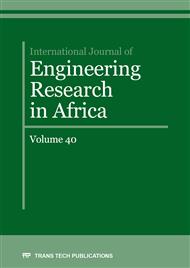[1]
Blackhurst, J., Craighead, C., Elkins, D., Handfield, R., (2005). An empirically derived agenda of critical research issues for managing supply-chain disruptions. International Journal of Production Research 43 (19), 4067–4081.
DOI: 10.1080/00207540500151549
Google Scholar
[2]
Dong-Wook Kwak, Young-Joon Seo, Robert Mason, (2018) Investigating the relationship between supply chain innovation, risk management capabilities and competitive advantage in global supply chains,, International Journal of Operations & Production Management, Vol. 38 Issue: 1, pp.2-21.
DOI: 10.1108/ijopm-06-2015-0390
Google Scholar
[3]
Trkman, P., De Oliveira M.P.V. andMccormack, K. (2016), Value-oriented supply chain risk management: you get what you expect,, Industrial Management & Data Systems, Vol. 116 No. 5, pp.1061-1083.
DOI: 10.1108/imds-09-2015-0368
Google Scholar
[4]
Revilla, E. and Saenz, M.J. (2017), The impact of risk management on the frequency of supply chain disruptions. a configurationally approach,, International Journal of Operations & Production Management, Vol. 37 No. 5, pp.557-576.
DOI: 10.1108/ijopm-03-2016-0129
Google Scholar
[5]
Heckmann, I., T. Comes, and S. Nickel. (2015). A Critical Review on Supply Chain Risk – Definition, Measure and Modeling., Omega 52: 119–132.
DOI: 10.1016/j.omega.2014.10.004
Google Scholar
[6]
Zsidisin, George A. and Lisa M. Ellram (2003), An Agency Theory Investigation of Supply Risk Management,, Journal of Supply Chain Management, Vol. 39, No. 3, pp.15-27.
DOI: 10.1111/j.1745-493x.2003.tb00156.x
Google Scholar
[7]
Norrman, A. and Lindroth, R. (2004), Categorization of supply chain risk and risk management,, in Brindley, C. (Ed.), Supply Chain Risk, Ashgate, Aldershot.
Google Scholar
[8]
Avelar-Sosa, L., García-Alcaraz, J.L., Castrellón-Torres, J.P. (2014). The effects of some risk factors in the supply chains performance: A case of study, Journal of Applied Research and Technology, Vol. 12, No. 5, 958-968.
DOI: 10.1016/s1665-6423(14)70602-9
Google Scholar
[9]
Zsidisin, G.A., Petkova, B., Saunders, L.W. and Bisseling, M. (2016), Identifying and managing supply quality risk,, International Journal of Logistics Management, Vol. 27 No. 3, pp.908-930.
DOI: 10.1108/ijlm-02-2015-0043
Google Scholar
[10]
Mariam EL HIRI, Abdelali EN-NADI and Anas CHAFI. (2018), Risk and Performance within Supply Chains - Case of Moroccan Industries- International Journal of Engineering Research in Africa, Vol. 34, pp.189-197.
DOI: 10.4028/www.scientific.net/jera.34.189
Google Scholar
[11]
Safaei, A. S., Farsad, S., & Paydar, M. M. (2018a). Emergency logistics planning under supply risk and demand uncertainty. Operational Research, 1–24.
DOI: 10.1007/s12351-018-0376-3
Google Scholar
[12]
Ashkan Hafezalkotob, Reza Mahmoudi, Elham Hajisami, Hui Ming Wee, (2018) Wholesale-retail pricing strategies under market risk and uncertain demand in supply chain using evolutionary game theory,, Kybernetes. Vol, 47. Issue, 6.
DOI: 10.1108/k-02-2017-0053
Google Scholar
[13]
Nguyen, H. V., Nguyen, H. T., Deligonul, S. & Cavusgil, S. T., (2017). Developing visibility to mitigate supplier risk: the role of power-dependence structure. Asia-Pacific Journal of Business Administration, 9(1), pp.69-82.
DOI: 10.1108/apjba-05-2016-0052
Google Scholar
[14]
George A. Zsidisin 2003, A grounded definition of supply risk, (2003) , Journal of Purchasing & Supply Management. 217–224.
DOI: 10.1016/j.pursup.2003.07.002
Google Scholar
[15]
Zsidisin, G., Panelli, A. and Upton, R. (2000), Purchasing organization involvement in risk assessments, contingency plans, and risk management: an exploratory study,, Supply Chain Management, Vol. 5 No. 4, p.171.
DOI: 10.1108/13598540010347307
Google Scholar
[16]
W. Xiaohui, Z. Xiaobing, S. Shiji, and W. Cheng, Study on risk analysis of supply chain enterprises,, (2006), Journal of Systems Engineering and Electronics, pp.781-787.
DOI: 10.1016/s1004-4132(07)60016-4
Google Scholar
[17]
R. Bhatnagar, and A. S. Sohal, Supply chain competitiveness: measuring the impact of location factors, uncertainty and manufacturing practices,, (2005). Technovation, Vol. 25, No. 5, pp.443-456.
DOI: 10.1016/s0166-4972(03)00172-x
Google Scholar
[18]
Svensson, G. (2002), A conceptual framework of vulnerability in firms' inbound and outbound logistics flows,, International Journal of Physical Distribution & Logistics Management, Vol. 32 No. 2, pp.110-34.
DOI: 10.1108/09600030210421723
Google Scholar
[19]
Johnson, E. (2001), Learning from toys: lessons in managing supply chain risk from the toy industry,, California Management Review, Vol. 43 No. 3, pp.106-24.
DOI: 10.2307/41166091
Google Scholar
[20]
Greenacre, M. J. (1984). Theory and Applications of Correspondence Analysis. London: Academic Press.
Google Scholar
[21]
Benzécri J.P . et coll. (1973) L'analyse des données. DUNOD, PARIS.
Google Scholar
[22]
M. J. Greenacre, Correspondence analysis in practice, Second edition. Chapman and Hall, (2007).
Google Scholar
[23]
A. Morin, Intensive use of correspondence analysis for information retrieval,, (2004), in Proceedings of the 26th International Conference on Information Technology Interfaces, ITI2004, p.255–258.
Google Scholar
[24]
S. Mignon-Grasteau, F. Minvielle, Relation between tonic immobility and production estimated by factorial correspondence analysis in Japanese quail, Poult. Sci. 82 (2003) 1839–1844.
DOI: 10.1093/ps/82.12.1839
Google Scholar
[25]
Mignon-Grasteau, S., Roussot, O., Delaby, C., Faure, J. M., Mills, A., Leterrier, C., Gue´me´ne´, D., Constantin, P., Mills, M., Lepape, G. & Beaumont, C. (2003). Factorial correspondence analysis of fear-related behaviour traits in Japanese quail. Behavioural Processes, 61, 69–75.
DOI: 10.1016/s0376-6357(02)00162-6
Google Scholar
[26]
Alwashali E., Jghalef B., Fadli M.,(2014).«Using the factorial correspondence analysis to determine the risks of water related diseases, hygiene and Good practices with survey data in Gharb area, Morocco». European Scientific Journal, edition vol.10, No.3 ISSN: 1857 – 7881 (Print) e - ISSN 1857- 7431.
Google Scholar
[27]
Meyer N, Ferlicot S, Vieillefon A, Peyromaure M, Vielh P, (2004), Intérêt de l'analyse factorielle des correspondances multiples en histopathologie. Ann Pathol, 24:149-160.
DOI: 10.1016/s0242-6498(04)93938-7
Google Scholar


